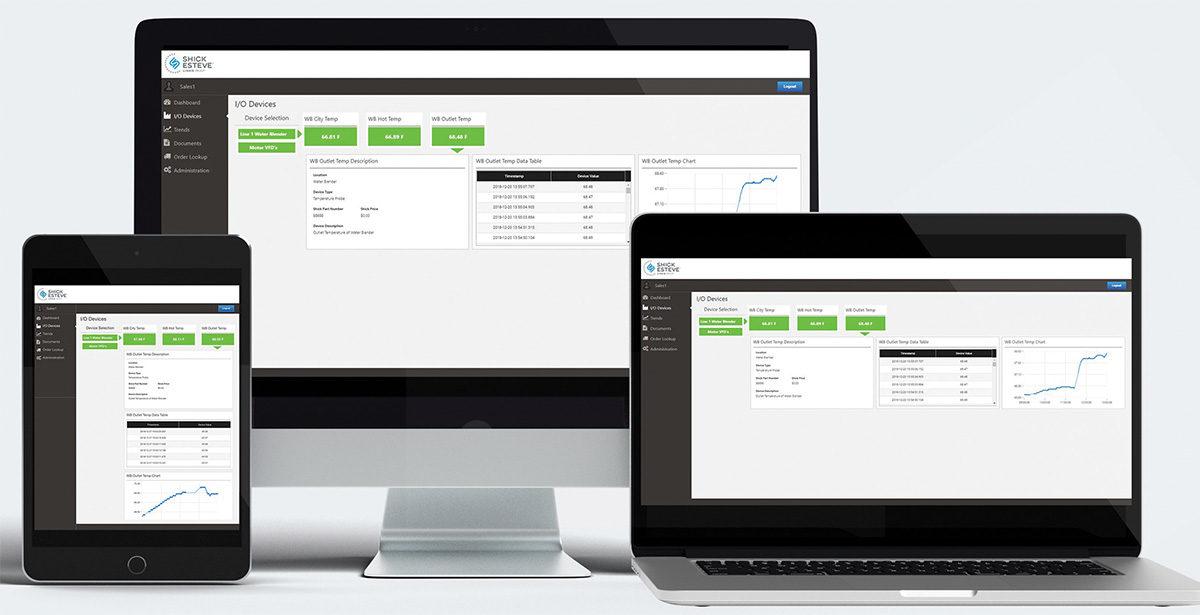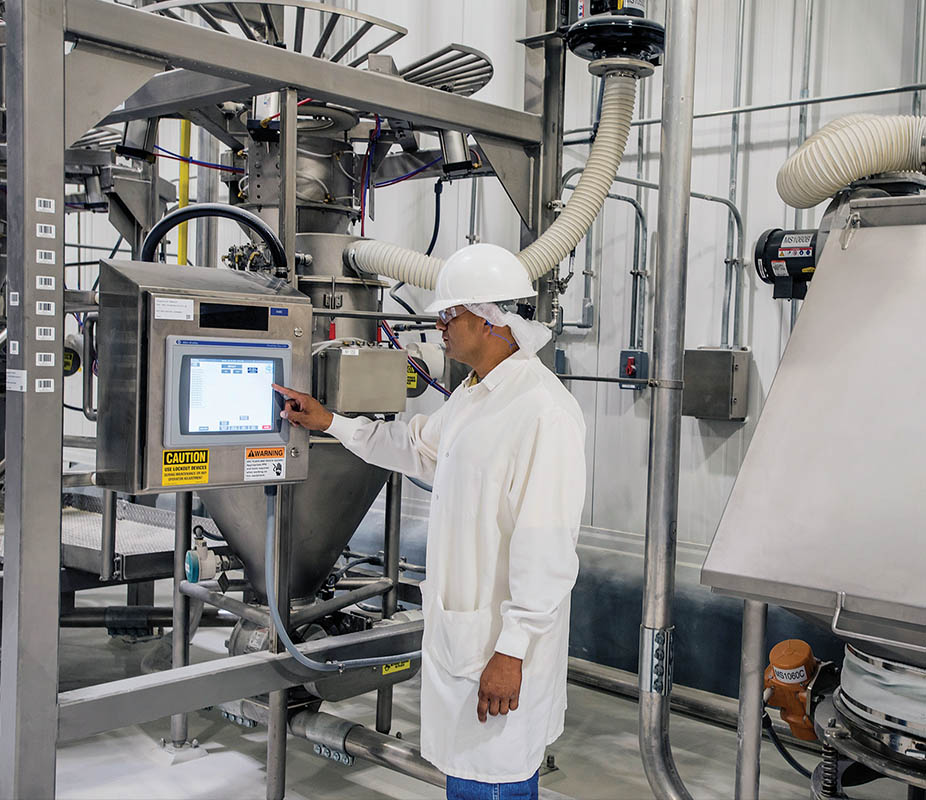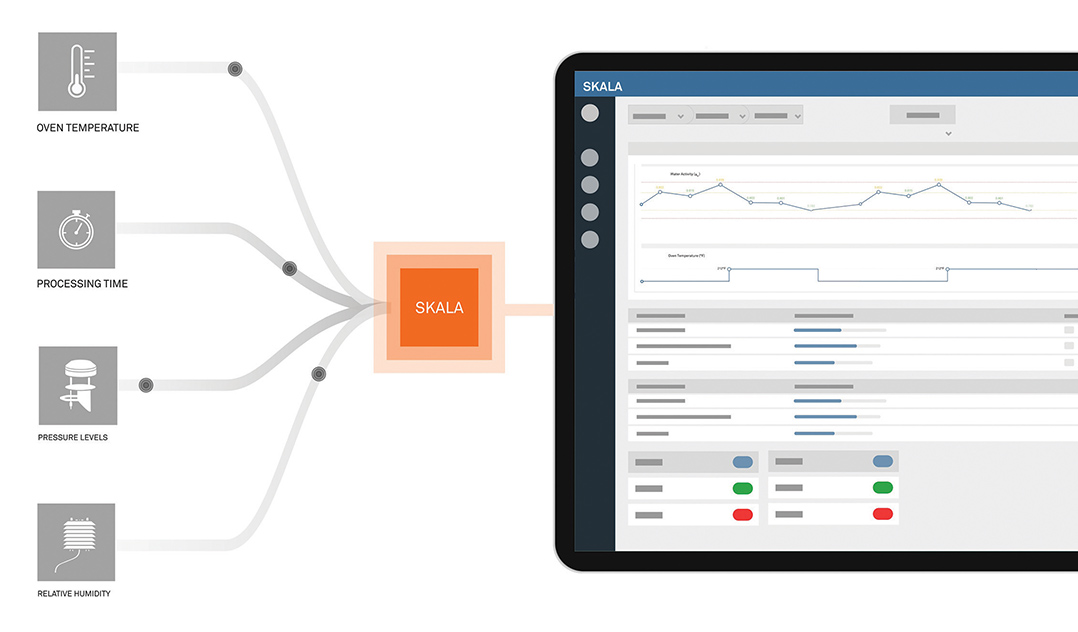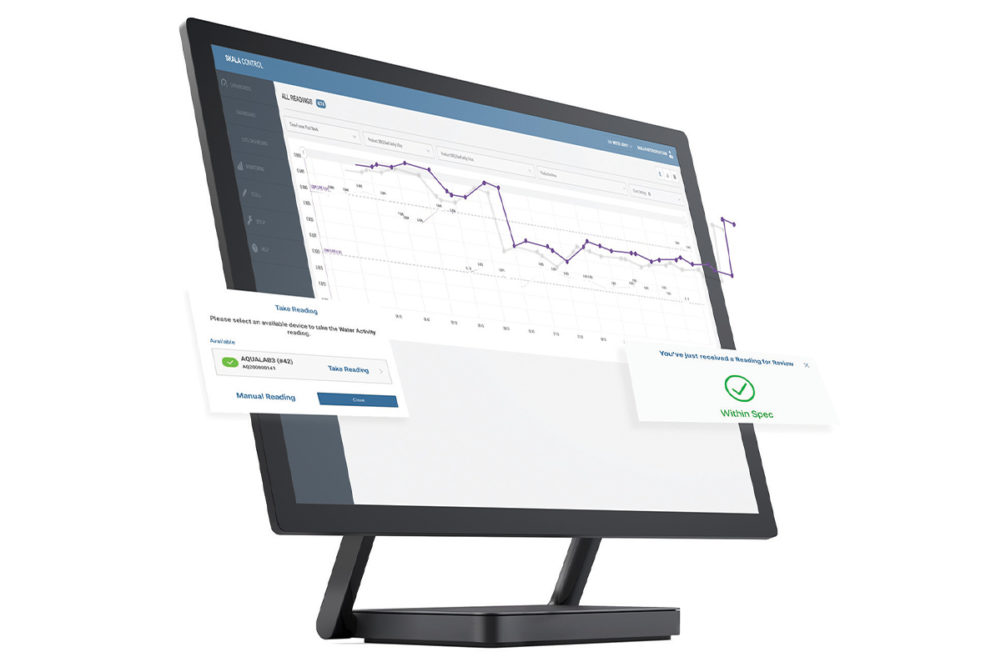This article was published in the June 2022 issue of Pet Food Processing. Read it and other articles from this issue in our June digital edition.
In the pet food industry, industrial control systems automate and enhance the processes for production and material flow. Any efficiencies or inefficiencies in this process are much more visible than legacy systems, so good control systems amplify productivity in a good process, therefore impacting overall production efficiency in pet food and treat processing applications.
Today’s control systems are all about utilizing 21st century technology, with smart control systems and connectivity being top of mind for all pet food companies.
 Modern control systems give manufacturers access to historical and simultaneous equipment performance data, allowing for a more proactive approach to process adjustments. (Source: Shick Esteve)
Modern control systems give manufacturers access to historical and simultaneous equipment performance data, allowing for a more proactive approach to process adjustments. (Source: Shick Esteve)
“Smart control systems contain proven and purpose-built control elements that are easily connected into live and historical data,” said Chris Wiley, account executive, pet food for Shick Esteve, Kansas City, Mo. “This enables production tools such as mobile dashboards, advanced process controls and predictive analytics.”
Matt Lueger, vice president of sales, NorthWind Technical Services, Sabetha, Kan., noted the industry is working to update its approach to control systems to make them more attractive to a younger workforce, such as having operational screens on mobile devices that look more like the apps they use every day and provide situational information relevant to what they need to know based on current conditions.
“We’ve changed our overall approach to touch screens to utilize high-performance graphics that highlight only pertinent information and have worked with industry partners to incorporate smart notifications based on machine parameters,” he said. “Additionally, we are currently updating our BatchLOGIX software to a web-based application that will allow for better mobility moving forward. We think that having a mobile operator workforce will help put operators and maintenance personnel close to the issues and help reduce downtime.”
Today’s technology can connect people to the plant just about anywhere. When communication technology is connected to the internet, mobile devices and new visual interfaces, it allows production teams to become more collaborative and effective, and the operating and maintenance support areas to grow to multiple facilities.
In older systems, costly communications bandwidth were installed and data was stored on premise with large servers. Programs were written to concentrate data and “squeeze out” maximum digital equipment utilization.
 The goal of advanced control systems is to improve the performance of human operators where possible, and eliminate the need for human interaction altogether if possible. (Source: Shick Esteve)
The goal of advanced control systems is to improve the performance of human operators where possible, and eliminate the need for human interaction altogether if possible. (Source: Shick Esteve)
“When internet technology began to spill over into the industrial space communications, controls were purchased with additional ethernet capabilities, and standard configurations made installation more intuitive and predictable,” Wiley said. “Communications and data storage became easier and more affordable. Now cloud storage, augmented reality, digital twins, electronic asset management, and an entire virtual platform are considered with smart control systems.”
Industry 4.0
Susan R. Newman, Ph.D., director of professional services, METER Group, Inc., a Pullman, Wash.-based instrument provider to the pet food industry, noted hands down, the latest trends emerging revolve around industry 4.0, which refers to a new phase in the Industrial Revolution that focuses heavily on interconnectivity, automation, machine learning and real-time data.
“COVID has made staffing difficult and, more than ever, pet food processors are reaching out for automation and closed-loop control systems that rely on fewer, yet more skilled workers,” she said. “If a machine can replace a human, pet food processors are in.”
The emerging technologies most valued are the internet of things (IoT) to connect data to actionable information, big-data analytics and machine learning to enhance performance and make adjustments at optimal times, and global access to data using cloud-based storage.
“Artificial intelligence and machine learning are changing the face of manufacturing and control systems,” said Susan Newman, Ph.D., METER Group, Inc.
“Artificial intelligence and machine learning are changing the face of manufacturing and control systems,” Newman said. “People and companies that are adept at quickly adapting and maximizing results from intelligent machines will have astronomical advantages well into the future.”
Whereas older systems worked by looking at data through the rearview mirror and trying to adjust in the next batch, today’s new solutions are bringing data at the micro-second interval and layering machine learning to make small, in-process adjustments that optimize production outcomes as well as result in safer products for pets.
Matthieu Garnier, vice president of operations, ADM Animal Nutrition, Decatur, Ill., noted technological advances in manufacturing control systems have improved calculation power, technical connectivity and data integration.
“Human Machine Interface (HMI) is designed for high performance, including properly designed screens and intelligent-use features such as alarms and event logging,” he said. “Connecting to mobile devices like tablets and smartphones supports field activities.”
Additionally, acquiring and integrating data with automated enterprise resource planning (ERP) and manufacturing execution systems (MES) enhances efficiencies and optimizes processes.
“In addition to our policies and procedures, we depend on a system that fits perfectly to the process it controls,” Garnier said. “For our animal and pet nutrition products, coordination and synchronization of simple line processes speeds up production rates, and ultimately improves service and reactivity.”
Tech in action
METER Group works with pet food companies to utilize some of these much-needed technologies. The company has made a strategic initiative to create an intelligent manufacturing system with two key facets: using AI to improve human performance at tasks that can’t be automated, and eliminating the need for human involvement in tasks that can be automated.
The company’s aforementioned intelligent manufacturing execution system is called SKALA. It helps companies transition from analog sensors and data collection to real-time, cloud-based machine learning, enables unsupervised self-optimizing control for drying and cooking, and many other industry 4.0 benefits – all with an elegant UX/UI that includes bank-level security and SOC 2 compliance.
 METER Group’s SKALA system measures real-time drying data to drive actionable insights for improving efficiency, food safety and consistency. (Source: METER Group, Inc.)
METER Group’s SKALA system measures real-time drying data to drive actionable insights for improving efficiency, food safety and consistency. (Source: METER Group, Inc.)
The company’s solutions span the production process. From incoming ingredient testing, using the most accurate and fast water activity and moisture analyzers (AQUALAB 3 and ROS 1) available on the market, to helping research and development with formulation and shelf-life optimization with the Vapor Sorption Analyzer (VSA), METER has designed its control systems for cloud-based ease and the delivery of results.
“In production, METER Group has received patents for closed-loop drying systems that use machine learning to predict in-process water activity and make adjustments to zones for optimizing safety as well as yields through delivering perfectly dried product every batch,” Newman said. “In packaging, we employ machine learning integrated with a simple software module to address overpack and identify when rework makes more sense through analyzing labor, packaging, and other rolled up costs.”
Shick Esteve engineers full-system automation solutions. From batch to continuous food manufacturing or process management, the company is dedicated to helping industry leaders around the world exceed standards for productivity and safety.
“We provide innovative solutions for data integration, process control and ingredient storage for our partners in food-related industries,” Wiley said.
The company combines smart devices and data with food ingredient automation, using a “food centric” approach to reduce complexity and risk to capture historical and real-time data. With each control system, Shick Esteve utilizes Clarity Process Management, an integrated data and process control tool.
“Clarity focuses on giving customers greater access to their data in a food production context,” Wiley said. “Clarity integrates with new and existing automated ingredient handling systems. This software provides recipe and batch management, process control, production scheduling, lot tracking/traceability, and process data acquisition. It can integrate with various front-end management software seamlessly. All data can be stored onsite or in the cloud, allowing for extensive and complete recordkeeping.”
Lueger said that today’s technology allows for more usable data.
“More field components are becoming ‘smart’ components with ethernet connectivity and their own IoT notifications,” he said. “For processing applications, our BatchLOGIX recipe management system is critical to validation of ingredients as they relate to the current process and traceability throughout the facility.”
Impacting efficiency
Closed-loop systems make adjustments at the perfect time to reduce downtime and manufacture a product exactly the same way every time, despite environmental and other variation that may occur naturally.
Leveraging state-of-the art technologies helps ensure the unsurpassed quality and food safety of ADM pet nutrition products, Garnier noted.
“We see increased efficiencies with improved traceability, automatically tracking materials throughout the process, which quickens our response to alerts,” he said. “We also have greater control of process standards and are preparing for the industry 4.0 transition.”
Wiley noted the company’s Clarity Process Management allows customers to make real-time decisions that will maximize their production efficiencies.
“Controls technology provides data to act predictive instead of reactive,” said Chris Wiley, Shick Esteve.
“Controls technology provides data to act predictive instead of reactive,” he said. “More data is available anywhere to respond to actionable alerts. If data is clear, reliable and quickly noticeable, anomalies can be detected and action can be planned.”
METER Group’s solutions, like SKALA, bring the best practices for pet food manufacturing onto a single digital platform.
“Harnessing the power and accuracy of precision machine learning, a powerful form of AI, SKALA outperforms even the best operator,” Newman said.
With SKALA’s machine learning and closed-loop control systems, many of METER Group’s clients have seen an average 30% reduction in moisture variation and 6% reduction in energy consumption. Additionally, 100% first pass yield is another popular efficiency benefit, according to Newman.
“Because we are able to connect to PLCs and other cloud-based sensor data, we can make second-by-second calculations to make sure every continuous line or batch oven is perfectly performing and producing high-quality, high-profit products,” Newman said. “Plus, SKALA never calls in sick, takes breaks, takes vacations, needs training, or takes selfies during its 24/7/365 shift.”
Today’s pet food processors are operating on tight margins. Even a 0.5% increase or decrease in yield quickly adds up to make or break a company. Good control systems are the difference between winning and losing in today’s market, and industry 4.0 is required to make continuous improvements in well-designed processes.
Find more articles about the latest pet food processing technologies on our Equipment page.




